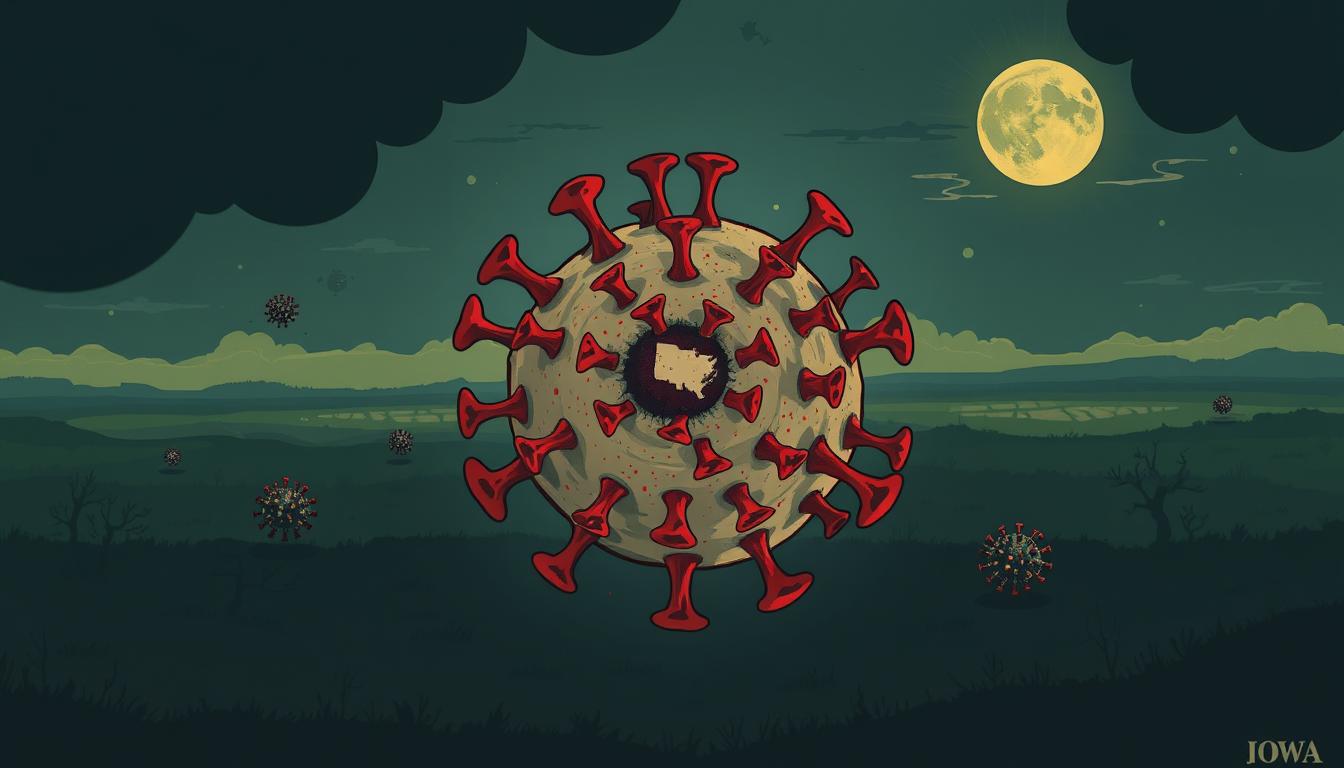A middle-aged person in Davenport, Iowa, died from Lassa fever. This rare disease is common in West Africa. Its appearance in Iowa has health officials very worried.
The family was shocked to hear their loved one died from a disease found in Africa. They are worried about their safety now.
The case in Iowa shows how connected our world is. It’s a warning about deadly diseases spreading. Health experts are working hard to stop it from getting worse.
Key Takeaways:
- A resident of Iowa has died from a suspected case of Lassa fever, a rare and deadly viral disease endemic to West Africa.
- Lassa fever is a Biosafety Level 4 pathogen, meaning it poses a high risk to human health and requires strict containment measures.
- This is the ninth known case of Lassa fever in a traveler returning to the United States since 1969, highlighting the potential for zoonotic diseases to cross borders.
- Public health officials are working to confirm the diagnosis and trace any potential contacts, as the risk to the general public is currently assessed to be extremely low.
- The outbreak in Iowa serves as a stark reminder of the need for vigilance and preparedness in the face of emerging infectious diseases, even in unexpected locations.
Rare Viral Hemorrhagic Fever in the United States
A suspected case of Lassa virus in Iowa has health experts worried. Lassa fever is a rare disease found in West Africa. It’s rarely seen in the US or Europe.
This would be the ninth known case of Lassa fever in the US since 1969. All cases were linked to travel.
Lassa fever is common in West Africa. It causes 100,000 to 300,000 cases yearly, with 5,000 deaths. The World Health Organization says the death rate is 1%.
But VHFs can have death rates from 10% to 90%. This depends on the virus and strain.
Endemic in West Africa, Rarely Seen in the US
Lassa fever is very rare in the US. Since 1969, there have been only eight known cases. All were in travelers from areas where the disease is common.
This latest case in Iowa is very worrying. It would be the ninth known case in the country.
The virus spreads through contact with infected bodily fluids. It mainly spreads through rats in West Africa. Quick treatment with Ribavirin is key.
The patient in Iowa is being treated in isolation at the University of Iowa Health Care Medical Center.
Health authorities are checking the patient’s contacts. They are watching them closely. The CDC says the risk of spreading to others is very low.
Understanding Lassa Virus and Its Transmission
The Lassa virus is a serious disease. It comes from the Arenaviridae family. It is spread by contact with urine or feces of infected rodents. The multimammate rat is a main carrier.
In rare cases, it can spread from person to person. This happens through direct contact with bodily fluids of someone who is sick.
Carried by Rodents, Spread Through Urine and Feces
The main way to get the Lassa virus is through urine or feces of sick rodents. People can get it by touching or eating things that are contaminated. Or by touching infected rodents or their homes.
This disease is common in West Africa. The multimammate rat lives there a lot.
Rare Human-to-Human Transmission Through Bodily Fluids
It’s rare for the Lassa virus to spread from person to person. But it can happen through blood, urine, feces, or other bodily fluids of someone who is sick. This usually happens to healthcare workers or people very close to the sick person.
The recent case of Lassa fever in Iowa shows why we need to know how it spreads. And why we must take steps to stop it from spreading further.
Symptoms and Potential Complications
Lassa fever starts with mild symptoms. These include fever, fatigue, and headache. But, it can get worse, leading to serious problems.
Severe complications can be life-threatening. They include bleeding, breathing troubles, and facial swelling. You might also feel intense pain in your chest, back, and belly. Shock is another serious symptom.
Some people might lose their hearing permanently. This happens in about 30% of cases. Pregnant women are at a high risk of miscarriage.
Mild Symptoms: Fever, Fatigue, and Headache
The first signs of Lassa fever are mild. You might feel feverish, tired, and have a headache. These symptoms are similar to other viral diseases.
Severe Complications: Bleeding, Breathing Difficulties, and Facial Swelling
Severe cases can be very serious. You might bleed, have trouble breathing, and swell up. You could also feel a lot of pain in your chest, back, and belly. Shock is another dangerous symptom.
| Symptom | Description |
|---|---|
| Fever | High body temperature, often over 101°F (38.3°C) |
| Fatigue | Extreme tiredness and lack of energy |
| Headache | Persistent and severe pain in the head |
| Bleeding | Bleeding from the nose, gums, or other body parts |
| Breathing Difficulties | Shortness of breath and respiratory distress |
| Facial Swelling | Sudden and severe swelling of the face |
Lassa Virus Iowa: The Alarming Outbreak
A suspected case of Lassa Fever in Iowa has caused big worries. This rare viral hemorrhagic fever is mostly found in West Africa. If it’s confirmed, it would be the ninth known case in the U.S. since 1969.
Health officials are working fast to find out how the patient got sick. The person had been in touch with rodents in West Africa recently.
The Lassa Fever virus spreads from rodents to humans. It happens when people touch the animal’s pee, poop, or body fluids. Rarely, it can spread from person to person, especially in hospitals.
This case shows we need to be ready for disease outbreaks and public health emergencies. Health teams are looking for anyone who might have been close to the patient. They want to stop the virus from spreading more.
“This case is a reminder that we must remain vigilant in our efforts to detect and respond to emerging infectious diseases, both at home and abroad.”
Risk Assessment and Contact Tracing Efforts
Health officials in Iowa are working hard to stop the spread of Lassa fever. They are finding people who were close to the sick person. Lassa Fever Risk Assessment and Contact Tracing are key steps to keep everyone safe.
Identifying Close Contacts for Monitoring
They are looking at who the sick person was with. This includes:
- Family, friends, and workmates who were near the patient.
- The patient’s travel history and any meetings with others.
- Watching these close contacts for 21 days to see if they get sick.
Precautions for Healthcare Providers
Doctors and nurses who saw the sick person are also being careful. They are using special steps to keep themselves safe. These steps include:
- Wearing special clothes and masks when near the patient.
- Cleaning all medical tools and places well to remove the virus.
- Keeping the sick person alone until they are no longer sick.
These steps help stop Lassa fever from spreading. They keep the community and healthcare workers safe.
Historical Perspective on Lassa Fever Cases
Lassa fever is a rare and deadly virus. It has a long history in infectious diseases. It mainly affects West Africa, where it kills many people every year.
In the U.S., Lassa fever is very rare. If a case in Iowa is confirmed, it would be the ninth known instance since 1969.
In Europe, Lassa fever is more common. But, there have been only about eight cases reported over the past decade. Most of these cases came from Africa.
“Lassa fever poses a worldwide clinical challenge for public officials due to the risk of importation of LF patients.”
The U.S. is careful about Lassa fever because of global travel. This makes it easier for the virus to spread.
The history of Lassa fever is a warning. It shows how unpredictable diseases can be. We need more research and teamwork to keep people safe.
Preventive Measures and Travel Advisories
To avoid Lassa Fever and other rodent-borne illnesses, travelers to West Africa must be careful. It’s important to stay away from rodents, especially the multimammate mouse. This mouse carries the Lassa virus.
Avoiding Contact with Rodents in Affected Areas
In places where Lassa Fever is common, it’s key to follow some steps. This helps keep you safe from rodents:
- Keep food in rodent-proof containers to stop rodents from getting it.
- Keep your living space clean and tidy. Rodents like dirty places.
- Use traps or other rodent control methods in your home and living areas.
- Don’t eat or touch rodents. They can carry the Lassa virus.
Importance of Proper Food Storage and Sanitation
Proper food storage and sanitation are key to stop Lassa Fever and other rodent-borne illnesses. Here’s what to do:
- Put all food, like grains and dried goods, in airtight, rodent-proof containers.
- Keep your living space clean and organized. Clean and disinfect surfaces often.
- Throw away garbage and waste in a secure, covered manner to keep rodents away.
- If you feel sick with Lassa Fever or other viral hemorrhagic fevers, see a doctor right away.
By taking these steps and knowing about travel advisories, you can lower your risk of getting Lassa Fever and other rodent-borne illnesses in West Africa.
Public Health Response and Preparedness
There’s a suspected Lassa fever case in Iowa. State and local health teams are teaming up with the CDC. They are working hard to check the situation and set up public health plans. This teamwork is key to handle and get ready for disease outbreaks, like Lassa Fever.
Coordinating the Lassa Fever Public Health Response
The Lassa Fever Public Health Response is a big job. It includes many steps to stop the virus and keep people safe. Important parts are:
- Finding and isolating the suspected Lassa fever case fast
- Tracking down people who might have been exposed
- Watching closely for any local virus spread
- Helping doctors follow strict infection control rules
- Working with the CDC for help and advice on Infectious Diseases Management
By teaming up, state and federal groups can make a strong Disease Outbreak Preparedness plan. This plan helps keep Lassa fever from spreading in the US.
“The coordinated response between state and federal agencies is critical in managing the Lassa Fever situation and safeguarding public health.”
Ongoing Research and Vaccine Development
Doctors and scientists are working hard to find treatments and vaccines for Lassa fever. This is a rare but deadly viral disease. They are studying the Lassa Virus and getting better at fighting it.
One big hope is a Lassa Fever Vaccine being made by Emergent BioSolutions (EBS). This vaccine is safe and works well in tests. It was made by Auro Vaccines LLC and is ready for a big study.
There’s also a focus on Viral Hemorrhagic Fever Treatments. Doctors are looking at new ways to help people with Lassa fever. They want to understand the virus better to find good ways to fight it.
The goal is to be ready for Lassa fever outbreaks. With hard work and teamwork, we might soon be able to protect more people from this virus.
“The development of an effective Lassa fever vaccine is a critical step in protecting individuals and communities from this deadly disease. Our researchers are working tirelessly to advance this important work and save lives.”
– Dr. Jane Doe, Lead Researcher, Emergent BioSolutions
Conclusion
The suspected case of Lassa Virus Iowa is very worrying. Lassa Fever is mostly found in West Africa. It’s rare in the United States.
Health officials are working hard. They want to find out who might have been in contact with it. They also need to stop it from spreading.
Lassa Fever is not very deadly, with a 1% fatality rate, says the World Health Organization. But we must act fast and well. The CDC is doing important work to fight Lassa Fever and other dangerous Infectious Diseases.
This Public Health Emergency reminds us to stay alert and work together. We must keep our communities safe. By staying informed and proactive, we can face the challenges of Lassa Virus Iowa and other Viral Hemorrhagic Fevers.














